Do you want to learn about Red Insects in Idaho?
Searching for information about Red Insects in Idaho was not as easy thing as I thought. Some articles did not have enough information, some were incorrect, and some just did not distinguish insects based on colors.
That is why I created this post about the 10 Red Insects in Idaho.
According to the insect identification database, there are about 75 insects that fit into this category in either Idaho or the United States.
This article will not only teach you about 10 Red Insects in Idaho, but also interesting facts about them, and beneficial information on how they live within their ecological environments.
10 Red Insects in Idaho
#1. Boxelder Bug (Anomala orientalis)
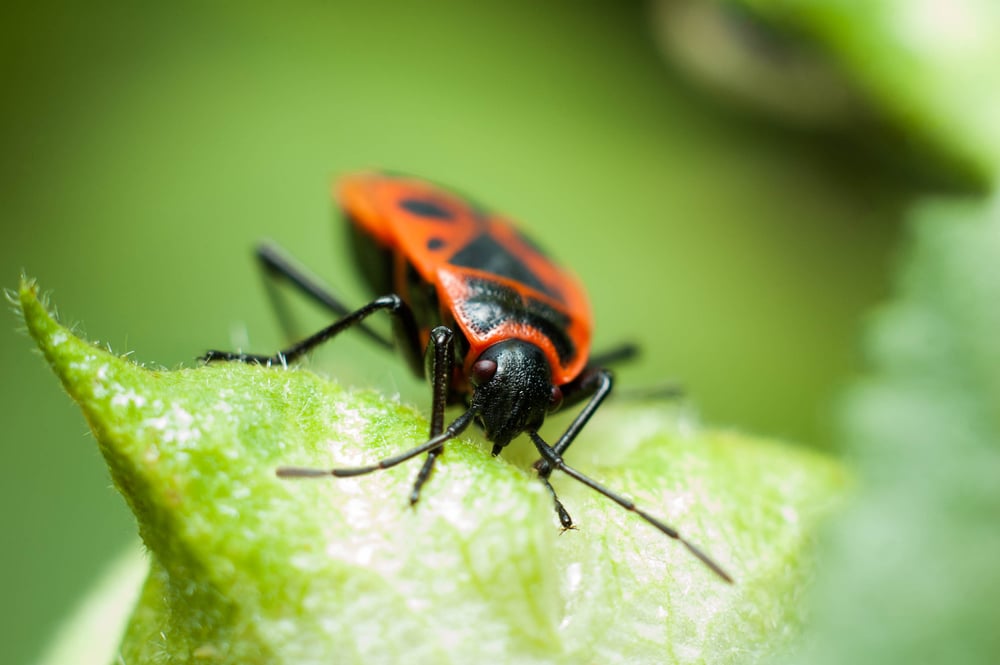
Identifying Characteristics and Facts
- Flattened body and about ½ inches in body length.
- Have a red accent with a yellow-orange stripe on the back.
- Can be a nuisance in homes and businesses, but are not harmful to human beings.
- They emit foul odors when they are disturbed.
- Feed on seeds of boxelder trees.
The Boxelder bug has red-orange accents and is common in Idaho or the United States. The eyes of this insect are also red. You will spot these bugs in maple trees, ash trees, and mostly in boxelder trees as the name suggests.
The reason why these insects love boxelder trees is because they feed on their seeds. These bugs are active mostly during the fall, and they usually gather in large numbers so that they can overwinter.
It is worth understanding that Boxelder bugs are not harmful to humans. However, they are a great nuisance and usually emit foul odors especially when they are disturbed. Their behavior can also make them stain some furniture with their fluids.
#2. Western Conifer Seed Bug (Leptoglossus occidentalis)
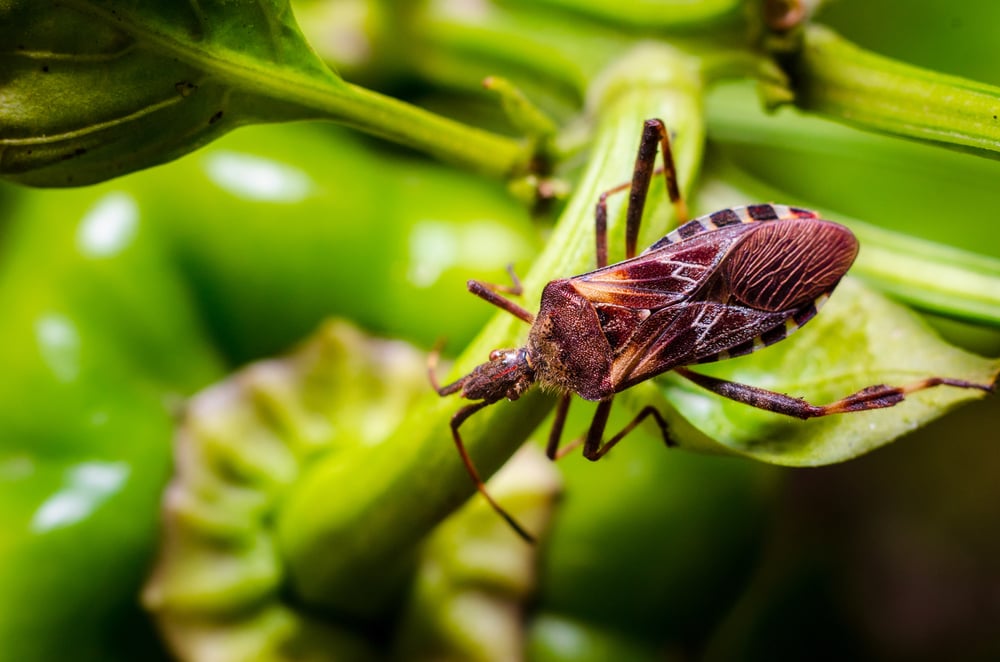
Identifying Characteristics and Facts
- About 19 – 25 mm in body length.
- They have flattened oval bodies.
- Reddish-brown with five transverse bands on the abdomen.
- Feed on the seeds, developing cones, and branches of conifer trees.
- Usually shelter in homes and buildings, but do not transmit diseases to humans.
- Attracted to warmth and light.
- They emit some foul odor when they are disturbed.
The western conifer seed bug is one of the red insects you’ll find in Idaho or the United States. This is a very typical bug found throughout different parts of the United States, so it is common to even see it while on vacation.
This bug feeds on the seeds of developing cones of conifer tree species. These trees include pines, hemlocks, spruces, and the Douglas fir among others. They also feed on the young branches of these trees.
The thing you need to understand about Western conifer seed bugs (Leptoglossus occidentalis) is that they are not the major pests of conifer trees. However, you ought to know that they can damage their seeds. These bugs also do not harm or transmit diseases to humans.
#3. Red Velvet Ant (Dasymutilla occidentalis)
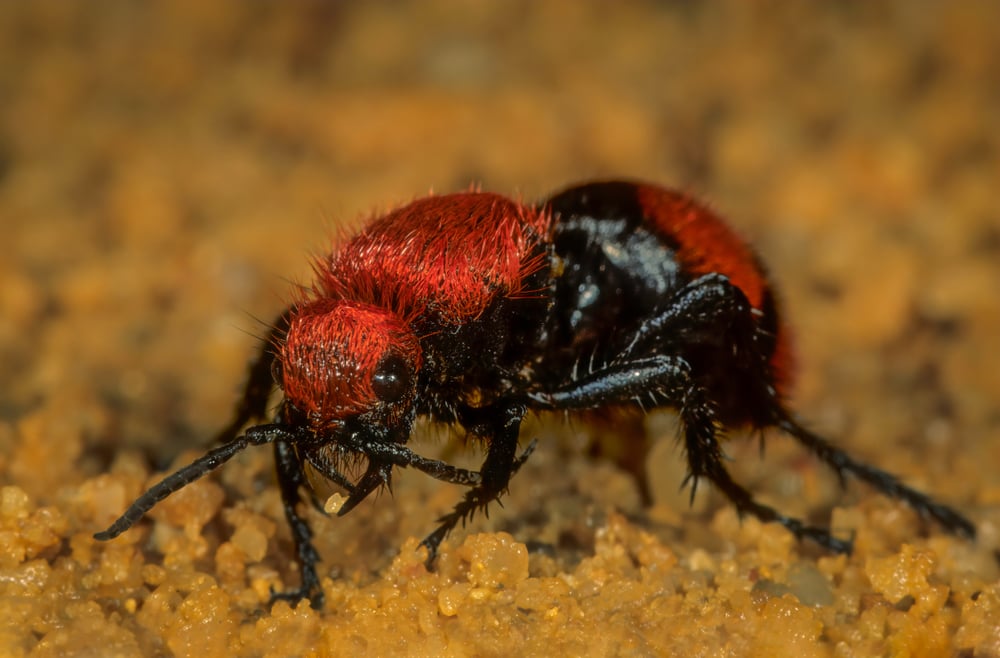
Identifying Characteristics and Facts
- Males have wings but females don’t.
- Most active during the daytime.
- Usually inhabit open and grassy areas.
- Not aggressive but can sting when disturbed.
- Their sting is considered extremely painful.
- Parasitic and do not build nests.
Red velvet ants are infamous for their sting earning them the nickname ‘cow killer.’ They are usually in Idaho or other parts of the United States.
It is important to note that red velvet ants aren’t generally aggressive and will only resort to stinging if they perceive a threat. The pain resulting from a red velvet ants sting can persist for about half an hour.
Unlike wasps, red velvet ants do not construct nests. The females lay their eggs individually on the immature stages of other insects like ground-nesting bees, wasps, and occasionally flies and beetles.
#4. Red Milkweed Beetle (Tetraopes tetrophthalmus)
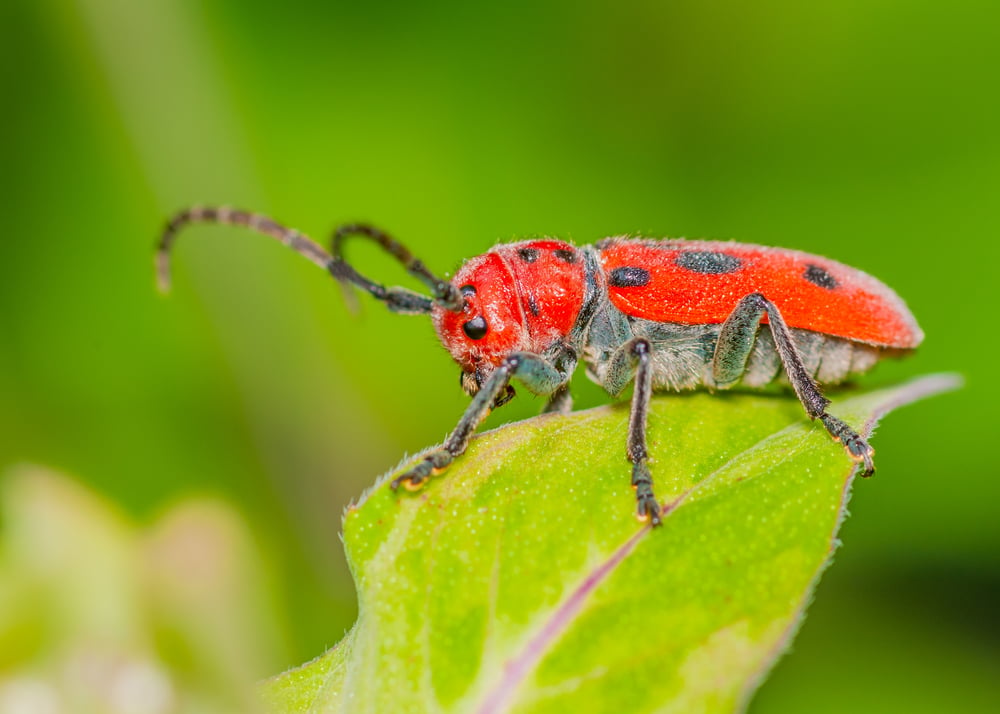
Identifying Characteristics and Facts
- Vibrant red or red-orange body.
- About 8 – 12 mm in body length.
- Have a narrow-cylindrical and elongated body shape.
- Inhabit open areas, grasslands, and meadows.
- Feed on milkweed leaves and even flowers and help in the pollination of milkweed plants.
- They undergo a complete metamorphosis.
The Red Milkweed Beetle is an insect that belongs to the longhorn beetle family Cerambycidae. This particular species can be found throughout North America or is common in Idaho.
What stands out are the red color, black spots, and long antennae. That is the reason behind its name. It inhabits grasslands, meadows, and gardens where there are milkweed plants, and is evident that it primarily relies on milkweed plants for sustenance and shelter.
While adult beetles primarily consume milkweed leaves, they also eat nectar from flowers. Interestingly, these beetles have a defense mechanism where they store toxic compounds from milkweed in their bodies for deterring predators.
#5. Red-Banded Leafhopper (Graphocephala coccinea)
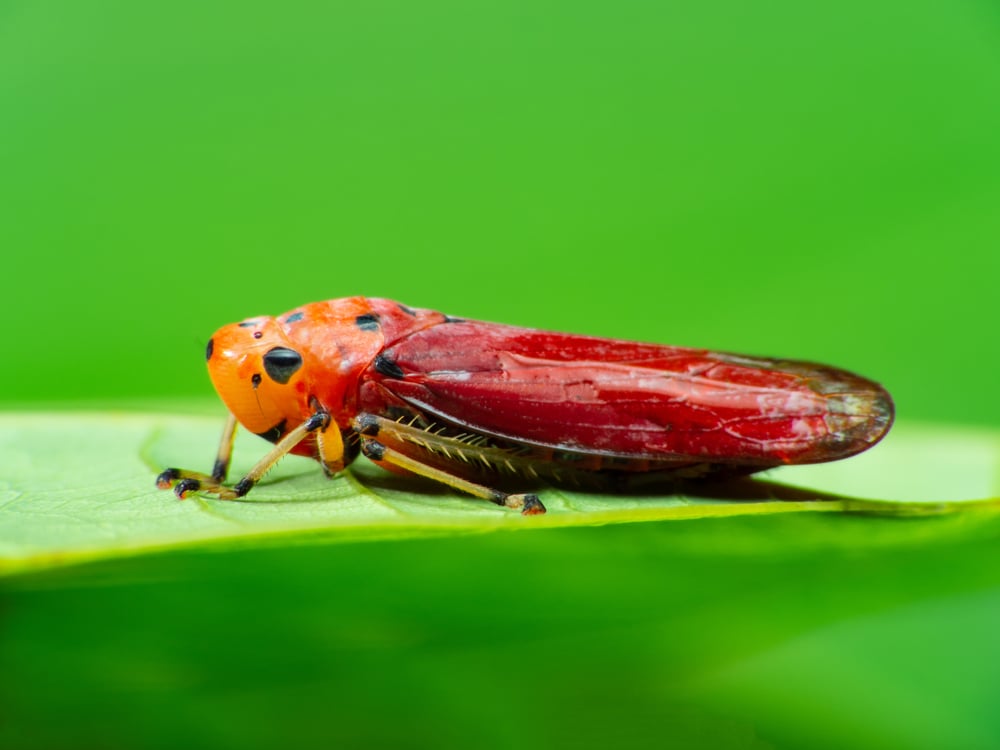
Identifying Characteristics and Facts
- About 6.7 – 8.4 mm in body length.
- Have vivid red stripes on the wings.
- Undergoes incomplete metamorphosis.
- Feed on plant sap and other small insects.
- They inhabit meadows, vegetable gardens, and woodlands.
- Available in various habitats.
- Have proboscis for sucking food.
These leafhoppers are commonly found in habitats, like gardens, forests, and agricultural fields in Idaho or many parts of the United States.
They feed on plant sap by using their mouthparts as piercing-sucking insects. Despite their size, they can cause harm to plants resulting in stunted growth and reduced crop yields. Therefore, there is a need to control their populations to avoid the damage that they can cause to crops.
This insect is also famous for its jumping ability using its hind legs to swiftly move from one leaf to another.
#6. Red Assassin Bug (Pyrrhocoris apterus)

Identifying Characteristics and Facts
- About 9 – 12 mm in body length.
- Strong flyers with fully developed wings.
- Emit foul smells when disturbed.
- Primarily feed on aphids and caterpillars.
- Vibrant red body coloration.
- Inhabit meadows, gardens, and agricultural fields.
The Red Assassin Bug is an insect that belongs to the Hemiptera order. It stands out with its black coloring and striking red body and you can spot them in Idaho or as well as in various parts of the United States, Europe, and Asia.
With a length of about 9 – 12 mm, this predatory bug has quite an appetite. They enjoy feasting on a wide array of insects, including troublesome pests, like aphids.
What makes the assassin bug truly unique is its hunting technique. It uses its proboscis to inject saliva into its prey effectively turning their insides into liquid before slurping it up.
While highly beneficial for agriculture by keeping pests in check, the Red Assassin Bug can sometimes become a nuisance when it seeks refuge inside homes during cold seasons.
#7. Red-Headed Bush Cricket (Phyllopalpus pulchellus)
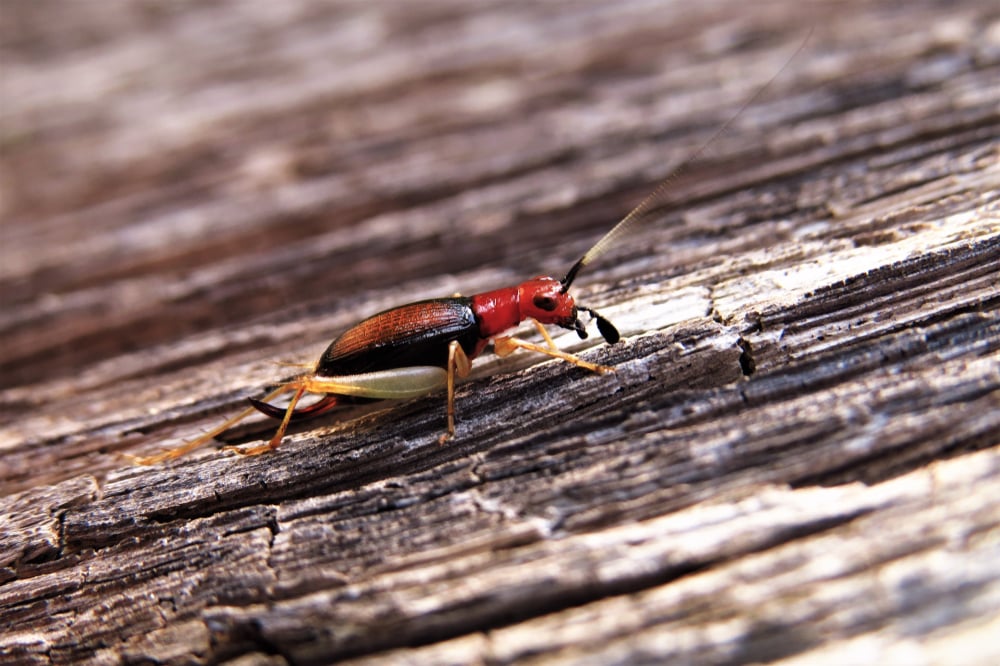
Identifying Characteristics and Facts
- They are approximately 1 cm in length.
- Distinct redhead and the thorax.
- Inhabit meadows, grassy areas, and woodlands.
- Have excellent jumping skills.
- Feed primarily on vegetation and plant matter.
- Females usually lay eggs in the soil.
- Can easily blend with the surroundings to avoid predators.
The Red-headed Bush Cricket is a captivating insect species that you can find in Idaho or many parts of the United States.
These crickets are quite small measuring around 1 cm long and are recognized for their head and thorax which stand out against their reddish-brown, or green bodies.
They typically inhabit woodlands and meadows where they utilize their jumping abilities to evade predators and capture their prey. During the mating season, the male crickets produce a buzzing sound that is high-pitched to attract the females.
As herbivores, the Red-headed Bush Crickets primarily feed on vegetation and plant matter. They thus play a role in the ecosystem by contributing to nutrient cycling and serving as prey for predators.
#8. Red Admiral Butterfly (Vanessa atalanta)
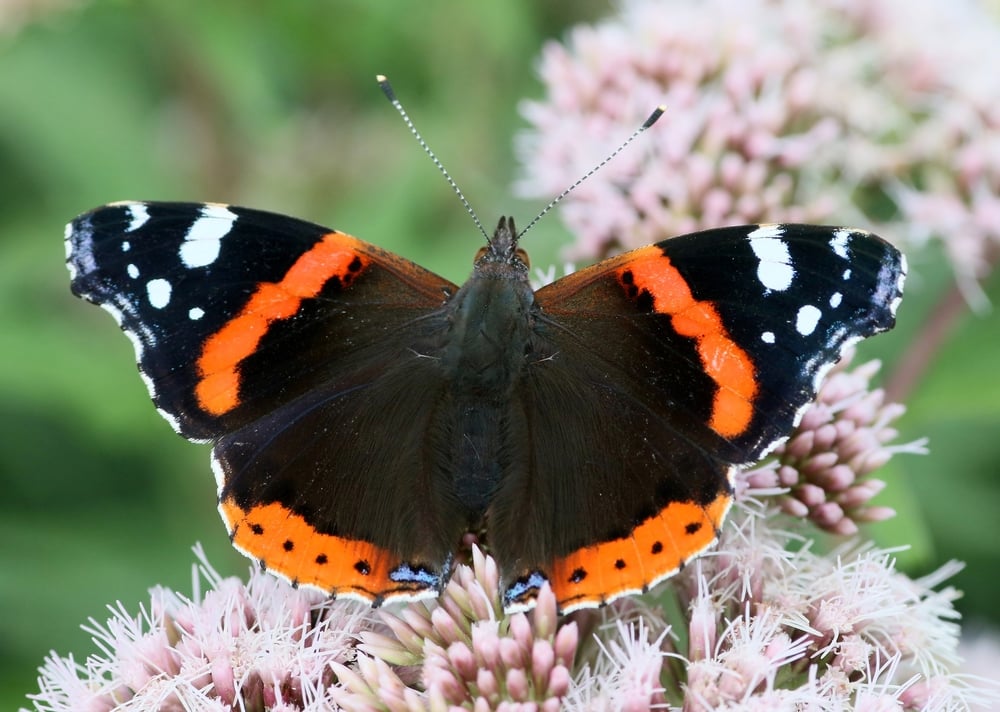
Identifying Characteristics and Facts
- Have a wingspan of about 2 inches in length.
- Red bands on the wings form the dominant color.
- Migratory and can travel long distances searching for wintering habitats.
- Caterpillars usually feed on stinging needles.
- Great flower pollinators.
- Non-toxic and not harmful to humans.
The Red Admiral butterfly is a bit large in size. It has wings that are black, with red bands and white spots. Of course, red is the dominant color which is why the name.
It is a common red insect you can find in Idaho or in some other parts of the United States. You will frequently see them in gardens and open spaces among other habitats.
One thing known about these butterflies is their migratory nature. They usually migrate distances between summer and winter in search of wintering habitats.
When it comes to feeding, the adult butterflies nourish themselves by sipping nectar from flowers while their caterpillars feast on stinging nettles. It also plays a role in the ecosystem as it aids in pollinating flowers and regulating stinging populations.
#9. Red-Tailed Bumblebee (Bombus lapidarius)
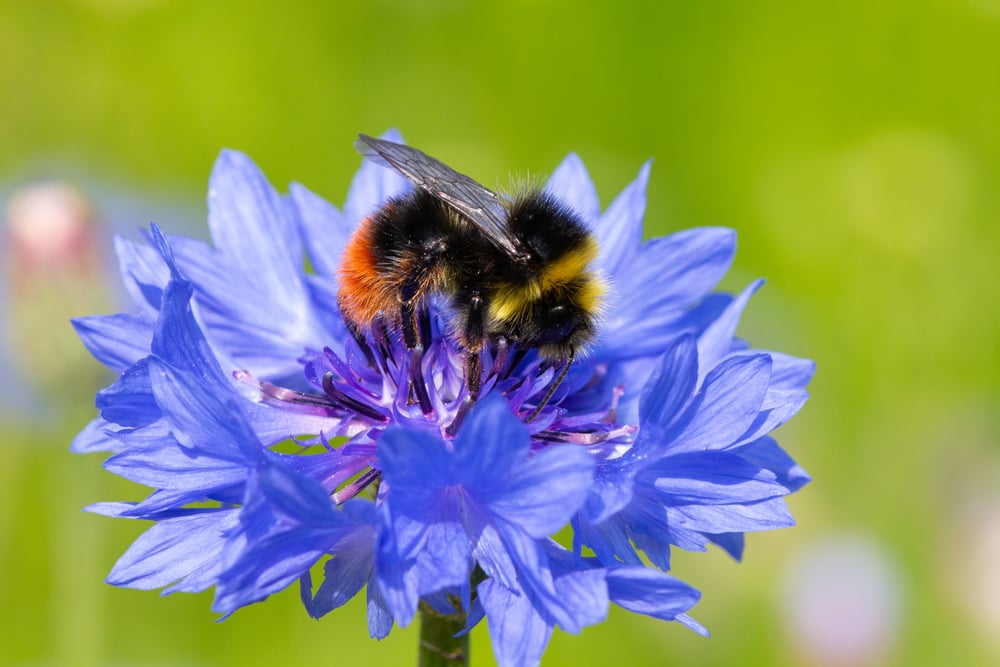
Identifying Characteristics and Facts
- Are social and live in colonies.
- Red markings on the abdomen region.
- Great pollinators to a variety of flowers.
- They can sting when they feel threatened.
- They usually nest underground.
The red-tailed bumblebee is easily recognizable, by its body with red markings surrounding the abdomen. It is one of the red insects in Idaho or fairly distributed in many parts of the world, including the United States.
The queen is notably larger than the worker females while the males have hair and bright yellow bands on both ends of the thorax along with a similar red tail to females.
These bumblebees play a role as pollinators. They are known to visit a diverse range of flowers such as daisies, dandelions, and thistles hence helping in their pollination. They usually build their nests underground and they stay in colonies.
The colonies can vary in size from a few dozen individuals to even thousands of individuals. It is also great to understand that the red-tailed bumblebees are generally not aggressive but they may sting if they feel threatened.
#10. Fire Ant (Solenopsis invicta)
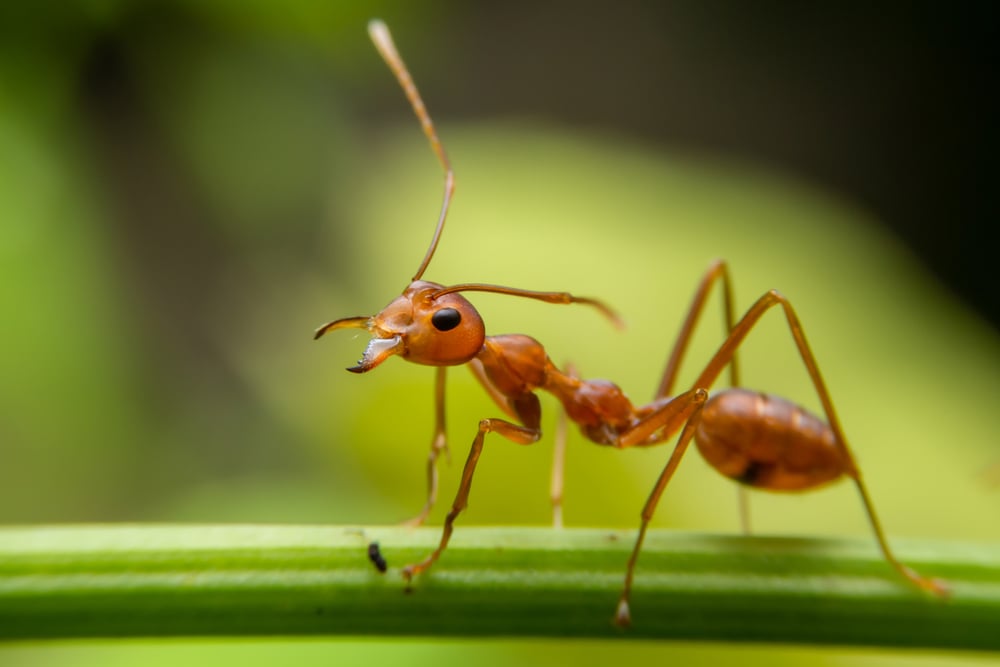
Identifying Characteristics and Facts
- Social and live in colonies.
- Build their nests in the ground or protected areas.
- Usually aggressive and can sting when disturbed.
- Major nuisances can cause some damage to properties.
- Can cause allergic reactions and even infections when it stings.
- Small and reddish-brown.
- Can grow up to 1/5 inches in length.
- Large eyes and some three teeth located in front of the head.
Fire ants are well-renowned for their small eyes and large eyes. They also have stingers and they can sting when they are threatened.
These insects are common in Idaho or other parts of the United States and are usually aggressive. Therefore, if you disturb their nest, they will defend themselves with their painful stings.
When it comes to behavior, fire ants are social insects. They, therefore, live in colonies and they build their nests in the ground. It is also important to note that their colonies are usually large with almost a quarter of a million individual ants.
As a reminder, the below factors are common for the most common red insects:
- Most can be found in your house, yard, or garden
- Most are not harmful to humans or pets but can be annoying and cause irritation
- There are easy ways to attract and deter red bugs in Idaho
- Most of these common red bugs can be easily removed or killed
